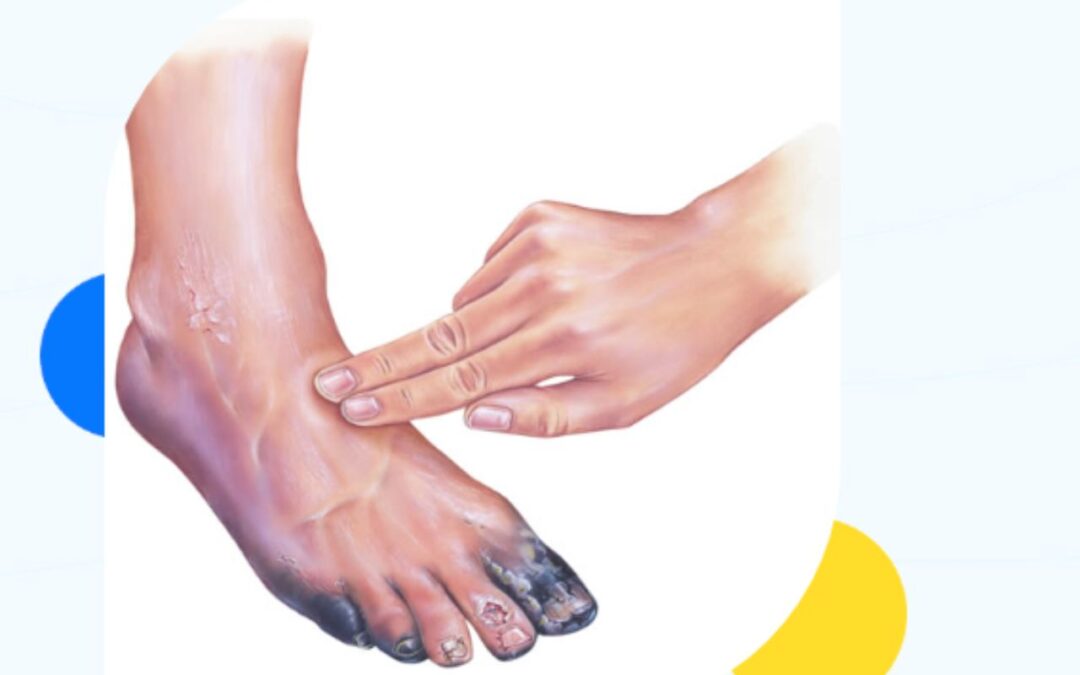For people with diabetes, foot care is generally the most forgotten aspect of daily management. But the cost of ignoring minor foot issues can be high, especially when it comes to an early stage diabetic foot ulcer. It may appear harmless at first, but it can quickly become a serious issue if left untreated. Prevention of serious complications starts with awareness, and that starts with knowing the warning signs, the risks, and the proper care guidelines
What is a Diabetic Foot Ulcer?
A diabetic foot ulcer is a foot sore or open wound, usually on the sole of the foot, caused by a cluster of conditions such as reduced blood flow, nerve damage (neuropathy), and elevated blood sugar. Such ulcers develop in people with poorly controlled diabetes and can start as small as a blister, callus, or cut.
At first, the ulcer is painless, ironically enough, that’s what makes it so lethal. Since the nerves are destroyed, most individuals don’t feel the initial trauma and continue walking on the surface, progressively damaging the wound.
Symptoms of Early Stage Diabetic Foot Ulcers
Detecting the early stage of the ulcer can significantly improve treatment. Be alert to these early symptoms:
- Redness or discoloration: The skin surrounding the wound will be red, dark, or inflamed.
- Swelling: Swelling of the foot or ankle, either painful or not.
- Warmth: The region feels warmer than the rest of the foot.
- Skin changes: Hard skin, corn, or callus on bony points can become ulcers.
- Fluid drainage: One may have discharge or spotting on the socks or shoes.
- Unusual smell: A pungent smell may be caused by underlying infection.
These symptoms do not appear too ominous on first inspection, particularly if painless, but could be prodromal symptoms of an incipient diabetic foot ulcer. Please get medical attention right away.
Who Is at Risk?
Certain factors are at a higher risk of acquiring diabetic foot ulcers:
- Uncontrolled blood glucose: Too much glucose prevents healing and permits infection.
- Peripheral neuropathy: Numbness in the feet may make you unaware that you’ve even been injured.
- Poor circulation: Reduced blood flow makes it harder for wounds to heal.
- Foot deformities: Flat feet, hammer toes, or bunions are pressure points.
- Inadequate shoes: Inappropriate and tight shoes are reasons for blisters and wounds.
- Past foot ulcers or amputations: History of ulceration greatly enhances the risk of recurrence.
- Smoking: Decreases blood supply and healing.
Diabetes control is an inclusive process, and foot care is the cornerstone of the system. Foot examination is required at regular intervals, especially among those in high-risk groups.
How to Take Care of an Early Stage Diabetic Foot Ulcer
Once an early stage ulcer is detected, appropriate care needs to commence at once to avert worsening. Below is a simple care plan:
1. Wound Cleaning:
Bathe the ulcer daily in saline solution or as your doctor advises. Apply strong antiseptics only if your doctor tells you to, they inhibit healing.
2. Offloading Pressure:
Try not to put pressure on the affected foot if possible. Your doctor can recommend a special boot, cast, or wheelchair to prevent putting pressure on the ulcer.
3. Dressings:
Cover the wound with dry, moisture-retentive dressings. Frequently change and keep the area dry in between changes.
4. Infection Control:
In case of suspected infection (e.g., spreading redness, fever, or pus), antibiotics will be administered. Never self-medicate; first consult an expert.
5. Blood Sugar Control:
Keeping your blood sugar in your range will accelerate healing. Monitor your blood sugar often and follow your diet and medications as directed.
6. Periodic Monitoring:
Get checked out on a regular basis by your physician. They can use diagnostic testing such as imaging or cultures to inform treatment.
7. Angioplasty or vascular recanalization:
If nothing works, an Interventional Radiologist or vascular expert may have to do angiography, identify blocked vessels with cholesterol or calcium and recanalize them with angioplasty or other modern techniques to increase blood flow to the ulcer bed and induce early healing.
Preventive Measures You Must Not Overlook
The ideal treatment for an ulcer of the foot is prevention of the same. Here are some tips:
- Do this every day in front of a mirror or ask a family member to assist you.
- Moisturize the feet to avoid cracking, but do not put lotion between toes.
- Trim carefully and don’t cut cuticles and hard calluses yourself.
- Wear diabetic-friendly shoes and avoid walking barefoot.
- Get routine foot checks by a podiatrist or diabetic foot specialist.
When to See a Doctor
If you notice any changes in your feet, especially if you see redness, swelling, a sore that doesn’t heal, or discharge, it’s time to see a doctor immediately. Early intervention can prevent infections, hospitalisation, or even amputations.
Final Thoughts
Diabetes doesn’t have to be a life with complications. Awareness of foot care and taking the initiative can keep you from suffering, from longer stays in the hospital, and from permanent disability. Don’t let the symptoms get worse, early prevention and early treatment are the pillars of diabetic foot care.
If you or your near and dear one is showing the symptoms of early stage diabetic foot ulcer, it is advised to see a foot specialist at the earliest. To receive the best treatment, visit Dr. Gaurav Gangwani, a renowned name in limb salvage and diabetic foot care.






